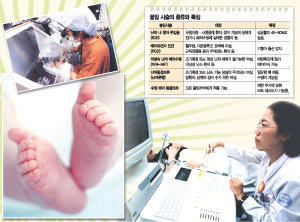The Success Rate of Fertility Therapy Hovers Above 50 Percent
The Success Rate of Fertility Therapy Hovers Above 50 Percent
Posted February. 22, 2004 22:49,

-An Accurate Understanding of Sterility
According to the 2002 data of the Korea Institute for Health and Social Affairs, 13.5 percent of the countrys couples are sterile. The causes of infertility can squarely lie with the husband and the wife, ranging from genital deformations to sperm or ovum abnormalities. Therefore, it is shameful to hold wives responsible for the sterility by brandishing the Confucianist seven valid causes for divorce. Frequently, wives are forced to take the therapy, although it is often the husbands who are sterile.
Fertility tests are covered by national healthcare insurance, however, the test tube baby programs are not. As a result, they range from hundreds to thousands of dollars in price. Public healthcare authorities plan to increase insurance coverage for fertility therapy, easing concerns among infertile couples.
Since the first success of the test-tube baby program, no new groundbreaking procedures have been discovered. However, the success rate of fertility therapy rose to 40-50 percent, compared with about 30 percent in its earlier days, led by the rising success rates of external fertilization and embryo implantation in the uterus. Female egg donations are a possible method against infertility, but they are not yet widespread in this country.
-Improving the Success Rate
A procedure that is gaining popularity is intracytoplasmic sperm injection, which is conducted on infertile males. With a success rate of 50 percent, healthy sperm is extracted and injected directly into their partners eggs, potentially resulting in a pregnancy.
Pre-implantation genetic diagnosis is also on the rise. It prevents the birth of a malformed child by preempting genetically defective fertilized eggs and admitting healthy ones into the uterus. The ethics debate over the determination of sex of fetuses still lingers. There is a procedure that takes immature eggs, completes their development in the lab and then injects sperm into them. And there are egg banks, which keep frozen eggs. However, defrosted eggs hold a low success rate of 10-20 percent.
Another treatment involves the freezing of embryos, which are later developed in test tubes for future transplant. This embryo transplant treatment is 30 percent successful.
Currently, research is underway to develop spermatogonium, the precursor of sperms, into normal sperms. Once successful, much of male infertility can be resolved. Also, there are attempts to artificially develop ovary cells into normal eggs.
-Preempt Infertility
Fertility researchers see age, obesity, smoking and sexually transmitted diseases as major non-innate causes for infertility. Being cautious about these four issues can improve fertility rates.
Females are born with about two million eggs. They do not produce any more eggs after birth. The number of eggs falls to 200-300 thousand during puberty. When women are in their 40s, the number drops to 20% of what it was initially. The success rate of test tube treatment is 50-60 percent when the patients are in their early 30s. The rate falls to 30 percent in their mid-30s and 20 percent in their 40s. If a woman has signs of infertility, she should ideally seek medical consultation before her mid-30s. A mans sperm production is affected minimally by his age.
About 12 percent of female infertility cases are due to obesity. Excessive body fat helps produce a high level of estrogen, which effectively works as a contraceptive. More often than not, infertile females get pregnant after losing weight. An excessively low level of body fat, however, also impedes pregnancy by disrupting the menstrual cycle.
Female smoking is deadly to fertility. According to a study conducted in the UK, about 13 percent of female infertility cases are related to smoking. Incomplete treatment of a STD can also cause infertility by permanently damaging the oviduct and other organs.
corekim@donga.com







